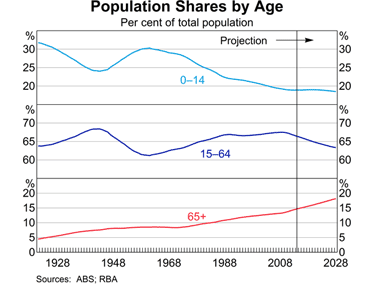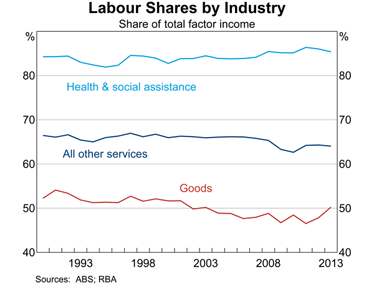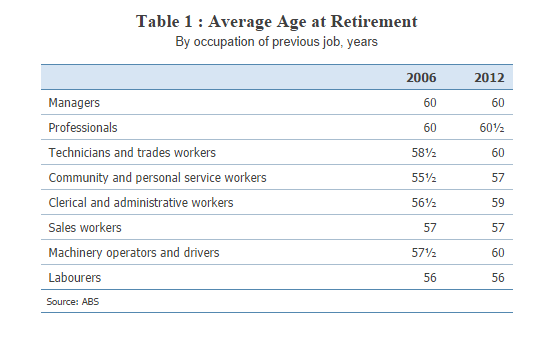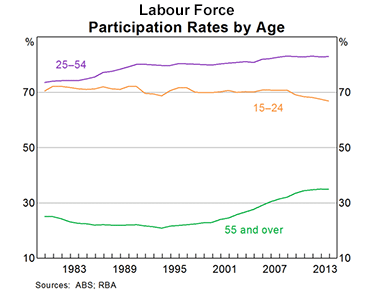Christopher Kent* †
Assistant Governor (Economic)
Address to the Leading Age Services Australia (LASA) National Congress
Adelaide - 20 October 2014
Near-term Outlook
I'd like to thank Leading Age Services Australia for the opportunity to be here today. I want to focus on some implications of population ageing for the longer-term outlook.
Before that, I'll make two remarks about the near-term outlook. First, with inflation expected to remain consistent with the 2–3 per cent medium-term target, monetary policy is currently configured to support growth in demand. Low interest rates temporarily raise the disposable incomes of those with debt, but lower incomes for those reliant on interest-bearing assets. This is stimulatory nonetheless, in part because the household sector is a net debtor overall. Low interest rates also encourage expenditure to be brought forward, provide an incentive for savers to shift into riskier, higher-return assets, and push up asset prices, to the benefit of those that own housing and equities.
A second point is that while monetary policy tends to focus on the outlook for the next few years – which is dominated by business cycle considerations – it is important for the Bank to account for longer-term structural changes. For example, labour force participation has declined noticeably over recent years. Much of this owes to the usual response of discouraged workers, both young and old, to subdued labour market conditions.[1] This discouraged worker effect is likely to unwind as conditions improve. But some of the decline also reflects the increasing effect of ageing on labour force participation.
This illustrates the point that to understand the near-term outlook better, we need to distinguish between shorter-term business cycle influences and longer-term structural forces. An increasingly important longer-term force is the ageing of the population, which is the focus of the rest of my presentation.
Population Ageing – Its Nature
Population ageing is driven by three different forces. The first is the baby boom that followed the Second World War. The second is the drop in fertility rates thereafter. Combined, these two changes led to a ‘bulge’ in the age distribution of the population (Graph 1). The early part of this cohort began to retire from around the turn of the century and the baby boom is increasingly putting downward pressure on the share of the population that is of (traditional) working age.[2]
Graph 1

The third force driving population ageing is rising longevity. Australians born today can expect to live nearly 25 years longer than those born a hundred years ago. The increase in life expectancy has occurred throughout this period and appears to be ongoing.
Population Ageing – Some Challenges
Conversations about ageing often focus on the challenges it poses. But it also provides us with numerous opportunities. Let's first consider some of the challenges and assume for the moment that behaviours don't respond to population ageing.[3]
(Relatively) fewer workers
If people were to retire at about the same age as in the past, population ageing would drive further falls in labour force participation rates over coming years.
The resulting decline in the supply of labour (relative to the total population) would tend to put upward pressure on wages (at least pre-tax wages) and reduce the returns to capital.[4]
The pressures on the labour supply will be felt more acutely by industries that rely more heavily on labour. Most notably, this includes services industries, such as aged care and health care (Graph 2). There is, however, likely to be scope for labour to be reallocated across services industries. In particular, an older population will require relatively fewer workers to care for and educate children.
Graph 2

More demand for services
At the same time as labour will tend to be in shorter supply, larger shares of the population will need a degree of assistance and care. Indeed, demand can be expected to shift towards services (away from goods) given that services constitute a larger share of total consumption for older people than for the rest of the population (Graph 3).[5] Much of this reflects spending on health care. This extra demand for services will be in addition to that associated with rising wealth. People tend to spend an increasing share of their rising incomes on services in part because there are ultimately limits to the consumption of food, wearing of clothes and use of other goods.
Graph 3

So, we can expect that ageing will lead to extra demand for services at the same time that it weighs on the supply of services (via declining labour force participation). More demand and less supply will push up the prices of services, relative to the prices of goods. This rise in the relative price of services has long been apparent for other reasons. One reason for this is that productivity growth has tended to be greater for goods than for services. That is, we've got better at producing more goods for a given level of inputs, more so than has been the case for services. Another reason is that the global integration of much of Asia over recent decades has brought large numbers of workers into the production of traded goods, increasing their supply and therefore pushing down the relative prices of goods.
It is important for stronger wage growth, and an increase in the relative prices of services to occur. Such signals will encourage higher labour force participation than would otherwise be the case and bring forth the additional supply of services that we will want and need.
Pressures on the public purse
Population ageing will place the public purse under a degree of pressure in a number of ways. Public revenues will face downward pressure given the declining share of the population paying income taxes.[6] Public expenditure will tend to rise given the demands on public pensions and the fact that many of the types of services that older people require are provided by the public sector directly.
Insufficient savings to fund retirement?
We are becoming wealthier and, through compulsory superannuation and other means of saving, we have gradually been building up private savings to fund retirement. But if we retire at much the same age as earlier generations had been used to, with longer lifespans on average we'll have to fund quite lengthy periods of retirement. Moreover, this will be an environment where there will already be considerable pressure on the public purse, for the reasons I have just noted.
Insufficient risk-taking and innovation?
One last challenge I want to raise relates to productivity growth. There is evidence that older people tend to be less willing to take on risks, including those associated with new business ventures, developing new products and services, and pursuing innovation more generally (Graph 4).[7] For this reason, it is possible that ageing could weigh on productivity growth, and hence on our incomes and economic wellbeing.[8]
Graph 4

Population Ageing – Opportunities to Meet the Challenges
Focusing only on the challenges would leave us with a rather gloomy picture of ageing. Fortunately, individuals and economies tend to be responsive to these sorts of challenges. Allowing relative prices to change and enabling individuals and businesses to alter their behaviours in response to those price signals is a critical part of the adjustment process. Applying a little foresight will also be helpful. And the key point I would like to emphasise is that rising longevity provides us with a number of opportunities to meet these challenges.
Longer working lives
Not only are we living longer, but life spans are also generally healthier than in the past.[9] Among other things, this provides the option of working productively later into life. Let me be clear though, extra years of work need not imply less years in retirement. (I'll come back to this point in a minute).
Also, many (though by no means all) jobs are less taxing on peoples' bodies than in the past. This makes it easier to spend extra years of life in the work force, which is already happening to some extent. Many types of workers have been retiring a little bit later in life over recent years and participation rates among older people have been rising over a long period of time (Table 1 and Graph 5).[10], [11] Not surprisingly though, this change is not generally evident for those with very taxing jobs, such as labourers who tend to retire several years earlier than other workers. Greater opportunities for part-time work have helped to contribute to rising participation rates among older people. Changing social norms more generally – particularly for women – have also made a contribution to rising labour force participation.

Graph 5

A rise in wages – which I have suggested is in prospect over the longer term – would provide an incentive for people to enter and remain in the workforce. Incentives related to the provision of public pensions and the treatment of superannuation will also have a significant bearing on the labour force participation of older people.
Higher savings
It's possible that we will choose to use longer lifespans in such a way that, on average, we'll work some extra yearsand spend more years in retirement. It's possible that we'll increase the share of our lives in retirement. Indeed, that would make sense because as we become wealthier over time, we can enjoy the better things in life, including more leisure. In any case, we'll probably want and need more savings to fund additional years spent in retirement.[12]
One way to do this is to save more during each year that we work. The power of compounding returns means that this strategy would be particularly effective if we do so earlier on in our working lives. Working for longer is another option. Individuals can add to their own savings during extra years of work, and delay the time at which they start to drawdown private savings. Also, this allows them to make further contributions to public revenue (via income taxes) and delays any need they may have to draw on the public purse.
If we manage to build up savings in preparation for ageing – as I've suggested we should – ultimately this can be used to fund investment. That is, more savings will support a rise in the stock of an economy's productive capital. Even if that extra capital is not put to work providing additional services, it can still be used productively in more capital intensive industries. This would free up some labour to work in the services sector.[13]
Education
Longer life spans provide opportunities and incentives to gain more education or learn a trade, and to do so later into life. This result is relatively straight forward. Education and training, particularly beyond high school, are costly for the individual, in part because of the opportunity cost of foregone income. A longer working life raises the life-time returns to advanced education and training, thereby providing the incentive to do more of it.
Although other factors may be at work here, there is evidence that more people have been obtaining qualifications beyond high school over the past couple of decades (Table 2).[14] Raising our human capital should help to make our economy more productive.
Risk taking
As I have already discussed, a rise in the share of older people might reduce the extent of risk-taking and innovative behaviour in an economy. But that is not where this story ends. It is important to recognise that a decline in the share of people taking risks would raise the return to risk taking. A response of others to this incentive would help, in part, to offset the initial impetus to reduced risk‑taking flowing from population ageing.
It is also possible that longer life spans may make people more willing to take on risks at any given age. Why? Take the example of someone considering a new business venture. They might be more willing to do so knowing that they would have more productive years to take advantage of a successful business. Moreover, in the event of failure, they still have many productive years ahead to generate a decent income doing something else.[15] They could use those years to pursue a safer option to generate a living, or even take on a different risky venture. In short, ‘40 may be the new 30’ when it comes to comparing the willingness of the current generation to take on risk compared with those born only a few decades ago.
A role for immigration?
Is there room to counteract, or at least mitigate population ageing pressures through immigration? At the margin there is, since the median age of new immigrants is around 25 years, which is currently about 10 years less than the median age of the average Australian. But this effect is already in operation given the significant contribution to Australia's population growth from immigration over recent years. Also, with populations ageing globally, immigration cannot be a panacea for all economies.
Conclusions
In summary, ageing of the population will have an increasingly important bearing on various aspects of the economic outlook. Among other things, it will tend to weigh on growth of economic activity, labour force participation and the public purse. It may weigh on productivity growth to the extent that it leads to less risk-taking and innovation. It will also lead to a rise in the demand for a range of services, including aged care.
The economy will be best placed to handle these significant changes in factor and product markets if we are responsive to the resulting changes in relative prices and returns to factors of production. We'll be even better placed if we can act with a degree of foresight.
What sort of responses might we expect? It will make sense for a combination of extra savings to be built up and for us to do what we can to raise participation rates, including by having people work later into their lives. Extra capital from the rise in savings can be channelled into both goods and services, though it is likely that productive resources (labour and capital) will be required to shift towards the services sectors.
While the challenges are relatively obvious, one aspect of ageing presents us with valuable opportunities. Rising longevity will provide us with the ability and willingness to work later into life, without necessarily implying a change in the share of our lifetimes we spend in retirement. This will allow us to bolster participation, savings and reduce the burden on the public purse. Recognising that on average we'll enjoy longer lives, may also encourage a rise in education and training. We may also become more willing to pursue risky, innovative business opportunities at any given age compared with what had been the norm for earlier generations. Public policies have an obvious role to play, facilitating these adjustments where possible.
The Reserve Bank can best contribute to the necessary adjustments to population ageing by maintaining low and stable inflation. This does two things. First, it encourages investors and businesses to focus on generating real returns rather than trying to avoid the effects of high inflation. Second, it enables changes in relative prices and relative returns to factors of production to be observed more clearly than in a world where inflation is high and variable. And it is these price signals that will facilitate the necessary adjustments in behaviour.









Add a Comment
We encourage you to use comments to engage with other users, share your perspective and ask questions of authors and each other. However, in order to maintain the high level of discourse we’ve all come to value and expect, please keep the following criteria in mind:
Enrich the conversation, don’t trash it.
Stay focused and on track. Only post material that’s relevant to the topic being discussed.
Be respectful. Even negative opinions can be framed positively and diplomatically. Avoid profanity, slander or personal attacks directed at an author or another user. Racism, sexism and other forms of discrimination will not be tolerated.
Perpetrators of spam or abuse will be deleted from the site and prohibited from future registration at Investing.com’s discretion.